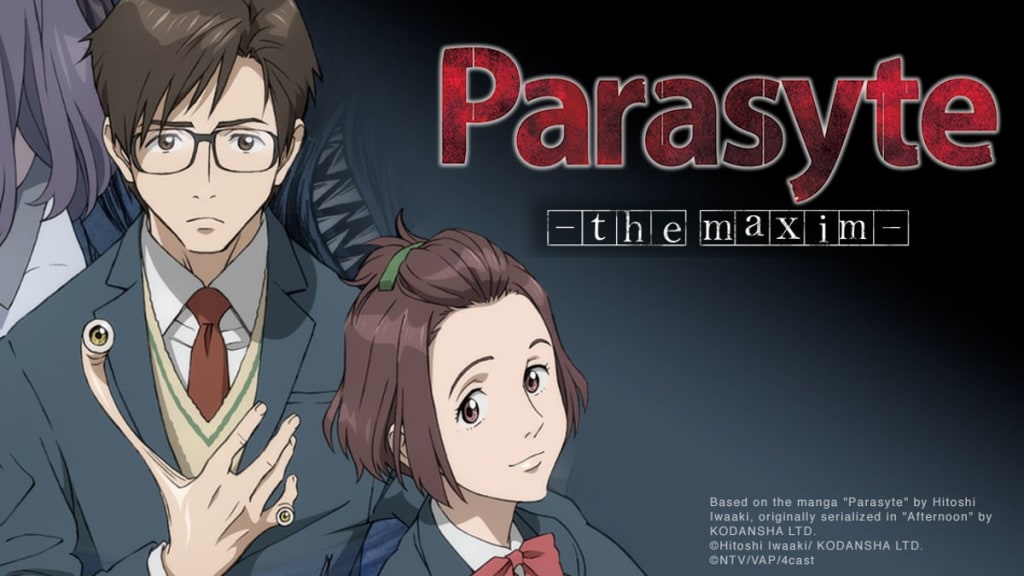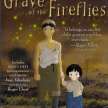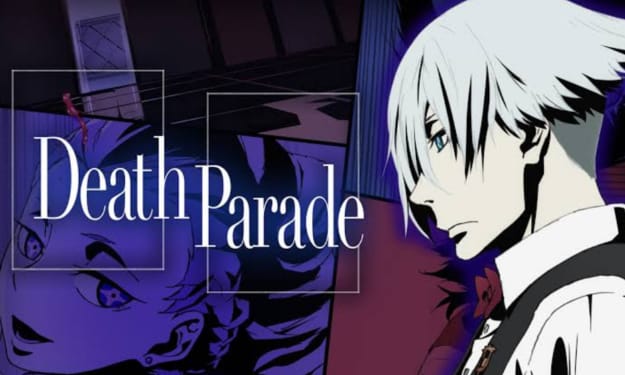Content warning
This story may contain sensitive material or discuss topics that some readers may find distressing. Reader discretion is advised. The views and opinions expressed in this story are those of the author and do not necessarily reflect the official policy or position of Vocal.
PARASYTE: THE MAXIM
Why you should watch Parasyte The Maxim anime

PARASYTE: THE MAXIM
"Parasyte" also known as "Kiseijuu" is a compelling manga series written and illustrated by Hitoshi Iwaaki. Serialized from 1989 to 1994, the story gained popularity for its unique take on the sci-fi horror genre. The manga consists of ten volumes, exploring the consequences of an alien invasion where parasitic creatures take control of human bodies.
The anime adaptation, released in 2014 to 2015, closely follows the manga's narrative, capturing the intense and thought-provoking themes.
With "Parasyte" Hitoshi Lwaaki masterfully combines elements of horror, science fiction, and psychological drama. Iwaaki's ability to craft complex characters and thought-provoking narratives has solidified his place in the manga industry.
1) Story
"Parasyte: The Maxim" follows the life of Shinichi Izumi, a high school student whose ordinary existence takes a dark turn when parasitic aliens invade Earth. These parasites take over human bodies by entering through the ears or nose, aiming to consume humans and take over the planet. However, Shinichi's case is different; the parasite, named Migi, fails to reach his brain and instead occupies his right hand.
As Shinichi and Migi grapple with their newfound symbiotic relationship, they face the growing threat of other parasites. The narrative explores themes of identity, morality, and the consequences of the parasitic invasion on both individuals and society. Shinichi becomes increasingly entangled in the conflict between humans and parasites, leading to intense and thought-provoking situations.
2) Main Characters
∆ Shinichi Izumi: The protagonist, initially a timid high school student, undergoes significant character development. As he grapples with the presence of Migi and the challenges posed by other parasites, Shinichi transforms into a more resilient and determined individual.
∆ Migi: The parasitic entity residing in Shinichi's right hand. Migi is analytical, pragmatic, and lacks the emotional depth of humans. Despite these differences, a complex bond forms between Migi and Shinichi as they navigate the dangers surrounding them.
∆ Satomi Murano: Shinichi's love interest and a classmate. Her character becomes pivotal as she grapples with the changes in Shinichi and the growing threat of parasites.
∆ Kana Kimishima: Kana possesses a unique ability to sense parasites, making her a target for these organisms. Her storyline revolves around her extrasensory perception and her attempts to understand and navigate the dangerous world of parasites.
∆ Reiko: A high-level parasite with intelligence and the ability to blend in with human society. Reiko takes an interest in studying human behavior and relationships, leading to a unique and thought-provoking character arc.
∆ Uragami: A human criminal who becomes fascinated with parasites. Uragami's character explores the darker side of human nature and the potential consequences of the parasitic invasion on society.
∆ Other Parasitic Entities: Each with unique abilities and personalities, these characters contribute to the suspense and moral complexity of the story. Some parasites act as formidable foes, while others raise questions about the nature of their existence.
3) Art and Animation
The art style in "Parasyte: The Maxim" is characterized by detailed and realistic character designs. The parasites, in particular, are depicted with a blend of grotesque and otherworldly features, emphasizing their alien nature. The human characters undergo noticeable changes as the story progresses, reflecting the impact of the parasitic invasion.
The animation quality in "Parasyte: The Maxim" is generally high, especially during action sequences. The fluidity of movement and dynamic choreography during intense scenes contribute to the overall impact of the series. The portrayal of parasite transformations and combat is visually striking, capturing the essence of the source material.
The design of the parasites is a standout element in both the manga and the anime. The animators successfully brought the disturbing and alien nature of the parasites to life, showcasing their ability to morph and transform their physical appearance. This contributes to the suspense and horror elements of the series.
4) Music
The music in "Parasyte: The Maxim" plays a crucial role in enhancing the overall atmosphere and emotional impact of the series. The soundtrack, composed by Ken Arai, skillfully complements the themes and intensity of the narrative.
∆ Atmospheric Composition: Ken Arai's score contributes significantly to the atmosphere of the series. The music ranges from suspenseful and eerie tones to more emotional and reflective melodies, effectively capturing the various moods presented throughout the storyline. This atmospheric composition adds depth to the viewing experience, immersing the audience in the world of "Parasyte: The Maxim."
∆ Evocative Themes: The soundtrack features themes that evoke a sense of tension, mystery, and horror, aligning perfectly with the themes of the series. During intense and action-packed scenes, the music heightens the sense of urgency and adrenaline, creating a visceral impact on the audience.
∆ Character Themes: Ken Arai introduces distinct musical motifs for different characters and situations, contributing to the overall character development and storytelling. The use of specific themes for key characters helps convey their emotions, struggles, and transformations, enriching the viewing experience.
∆ Opening and Ending Songs: The opening theme, "Let Me Hear" by Fear, and Loathing in Las Vegas, sets an energetic and intense tone, reflecting the series' action elements. The ending theme, "It's the Right Time" by Daichi Miura, provides a more emotional and contemplative contrast, capturing the evolving relationships and character dynamics.
5) Themes and symbolism
∆ Symbiosis and Mutual Dependency: Shinichi and Migi depend on each other for survival. Migi needs Shinichi's body to thrive, and Shinichi relies on Migi's heightened abilities to navigate the dangers posed by other parasites. This mutual dependency becomes a driving force behind their cooperation and forms the foundation of their unique partnership.
∆ Conflict of Nature vs. Humanity: The relationship serves as a microcosm of the broader theme in "Parasyte: The Maxim" – the clash between the parasitic nature and the essence of humanity. Migi, devoid of human emotions, contrasts sharply with Shinichi's complex emotional spectrum. This dichotomy becomes a source of internal and external conflict, highlighting the struggle to maintain one's humanity in the face of alien invasion.
∆ Character Development and Identity: As the story progresses, Shinichi undergoes significant character development influenced by his association with Migi. The lines between their individual identities blur, leading to introspective moments that question the nature of self and the impact of external forces on personal identity. This exploration adds depth to both characters.
∆ Communication and Partnership: Shinichi and Migi's communication becomes a fascinating aspect of their relationship. Through their conversations and shared experiences, they learn to coordinate effectively. Migi's analytical approach contrasts with Shinichi's emotional responses, creating a balance that becomes crucial in facing the threats posed by other parasites.
∆ Ethical Dilemmas and Morality: The partnership raises ethical questions about the morality of their actions. Shinichi must grapple with the consequences of Migi's actions, leading to moral dilemmas that challenge his understanding of right and wrong. This exploration of morality adds layers of complexity to their relationship.
∆ Hands as a Symbol: Hands hold symbolic significance, representing agency, action, and connection. Shinichi's right hand, housing Migi, becomes a focal point of symbolism, showcasing the transformative power of physical and metaphorical touch.
6) World Building
The world of "Parasyte: The Maxim" is a contemporary setting invaded by otherworldly parasites. The narrative carefully builds a society grappling with the unknown, incorporating realistic elements of daily life amid the chaos. The gradual revelation of the parasite-infested world adds layers to the storytelling, providing a rich backdrop for exploring themes and character interactions.
7) Overall Conclusion
"Parasyte: The Maxim" concludes with a poignant and impactful resolution to its narrative arcs. The series successfully weaves together intense action, philosophical exploration, and emotional depth. The characters' journeys, particularly Shinichi's, come full circle, leaving viewers with a thought-provoking reflection on identity, morality, and the delicate balance between humanity and nature. The series remains a standout in the realm of anime for its profound storytelling, unique themes, and memorable characters.
About the Creator
Murali
Hi guys
Enjoyed the story? Support the Creator.
Subscribe for free to receive all their stories in your feed. You could also pledge your support or give them a one-off tip, letting them know you appreciate their work.






Comments
There are no comments for this story
Be the first to respond and start the conversation.